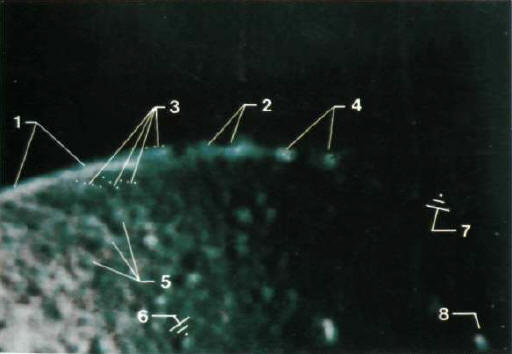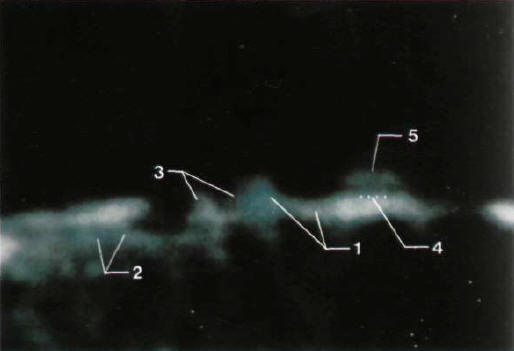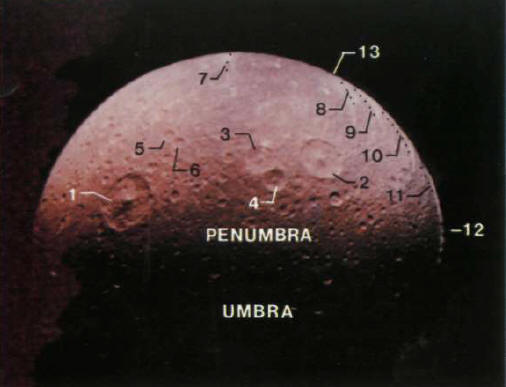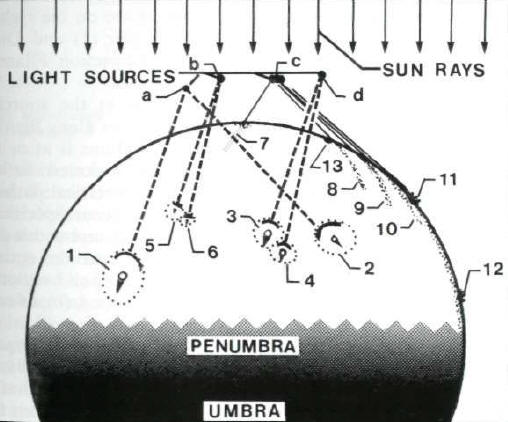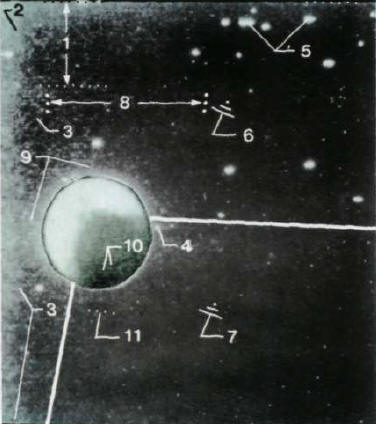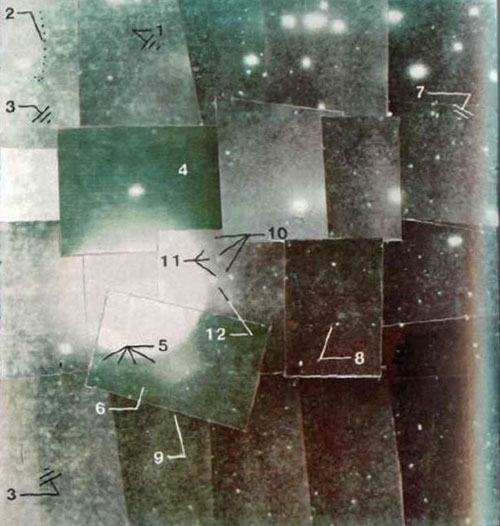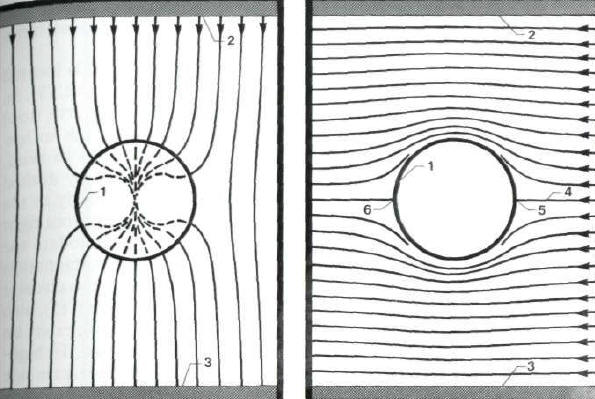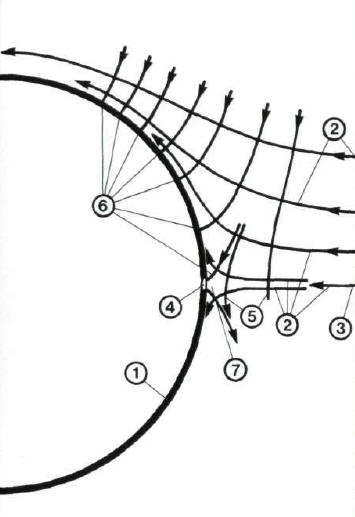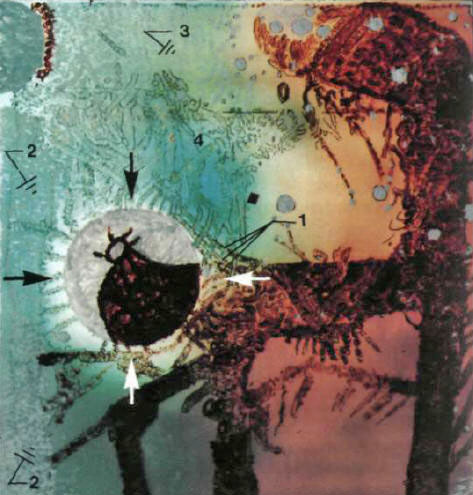|
OUTLYING BASTIONS
Then by an intermediate process, all yield outputs. Outputs consist not only of the intended products or services but also of refuse. As the Saturnian ring system so well illustrates, refuse can be seen much more readily than the producing sources. Dione also falls into this same pattern.
Specifically, over about 250 km (150 mi) of its landscape near the horizon, Dione displays a narrow, hazy-white elevated-surface band, (1), profusely emitting blue ejecta, (2) .
Plate 32 Luminescently active landscape on Dione.
This illuminated band appears to rise above the plain topography in the foreground by nominally 7 km (4 1/2 mi).
One part of the band consists of shapes approximating cylinders, (3), staggered in position abreast and crosswise of one another. Another part contains angular shapes, (4).
Foreground topography appears to consist of the same substance as the elevated band. However, emissions are not so pronounced; and the surface presents softer contours as though large lumps, (5), had fused together while in a malleable state.
Beyond the penumbra,* (6), well into the umbra, (7), where a solid shadow should occur, a spot of multi-colored illumination, (8), appears. In this completely shadowed region, the wall side of any crater is too low to intercept sunlight and cause reflection.
* A region partially illuminated by the sun.
Inferentially, the active topographical area stretches afar.
A conservative estimate is 73,000 square kilometers (28,000 sq mi). In comparison, terrestrial topographical coverage of naturally illuminated areas is miniscule. Further, the diameter of Dione is only about 1/11 that of earth. Clearly, the luminescent phenomenon on Dione has no earthly counterpart.
Subsequent considerations substantiate this observation. To investigate landscape detail, a microphotograph has been made of Dione's narrow-band illuminated topography.
This photograph, Plate 33, discloses numerous emissions emanating from many irregularly-shaped surfaces.
Plate 33
Dione's narrow-band
illuminated topography showing various types of emissions.
These emitting surfaces are similar to those characterizing matter in the F ring.
This occurrence is puzzling in that Dione presents mostly a starkly barren face packed with craters.
Then, in sharp contrast, active material resembling an F-ring section appears on its periphery. Were this active material of volcanic origin, each emission would assume a parabolic trajectory as spewed matter gravitated toward Dione's surface.
However, terrestrially familiar trajectory profiles do not occur. Instead, most emissions are like trees, (1), in that they simply terminate at some height above the surface. Others labeled re-entrant emissions, (2), connect with nearby objects. A few uniquely distinguish themselves by forming classical electrodynamic toroids, (3).
Still others act as lifting emissions, (4), to support an otherwise floating body, (5).
Because of similarity with the F ring, Dione's elevated electromagnetic band raises doubt as to its being indigenous. Earlier considerations have indicated that the F ring results from products discharged by electromagnetic vehicles. Hence, there is rationale for suspecting that the active material on Dione is not indigenous.
Conceivably, appropriately positioned vehicles may deposit the material.
Further inquiry into this ambiguity is focused upon peripheral space adjacent to the circumferential surface of Dione. First, the narrow-band topography is probed for additional information. Then, a critical look is taken of a hemispherical sector of Dione which encompasses the same topography.
However, a longer exposure time has caused new images to emerge.
Unfortunately, previously well-defined areas have turned white and lost detail from over exposure. Despite this difficulty, the floating body, (1), (labeled (5) in Plate 33), remains identifiable. Above (1) is positioned a truncated pyramidal superstructure, (2) on the side of which a toroid, (3), is attached.
An electro-filament, (4), extends from the side and reaches upward into space. Across the dark space to the left a cylindrical body, (5), having a ratio of span to diameter of about 8, is asymmetrically disposed about a circular object, (6). Another toroid, (7) , is located just to the right of the circular object.
These identifications raise a question of what lies hidden farther above the surface of Dione. Faint light markings, (8), indicate that other activity indeed does exist at a considerable distance away. Remote activity is incongruous with the concept that Dione's illumination is indigenous.
Suspicion is aroused that energy may be flowing into Dione inasmuch as the satellite can be regarded as being at low, or
ground electrical potential.
Plate 34 Dione's narrow-band illuminated topography
evidencing
widespread emissive activity.
Evidence supporting this notion would be expected to embrace a large surface area. After all, vehicles have size superiority, and their ultra-high-energy projections span long distances.
Plate 35 presents macro-views of Dione showing curvilinear surface markings and duality in hemispherical lighting. Part (a) provides photographic identifications and part (b), pictorial interpretation aids.
In the upper quadrant at the periphery, numerous rays curve inland from the moon's edge. These rays, numbered (7) through (11), comparatively are lighter in color than the surface.
Blue emissions, (12), are the same ones presented in Plate 33.
More blue emissions, (13), serve to
unite these rays conceptually as a family.
Latigus; 7, 8, 9, 10 and 11, Surface rays;
Macro-views of Dione showing curvi-linear surface
markings
and duality in surface lighting.
Consistency in directional alignment should prevail when the sun is the only external source of light. In particular, craters (1) through (6) contain shadow orientations inconsistent with sun-ray direction. Dashed lines are drawn in the direction opposite the shadows to diagram probable spurious light paths. Intersection of line pairs suggests the possibility of nearby secondary light sources, (a), (b) and (c).
Extrapolation of curved surface rays (7) through (11), indicated by solid lines, produces a companion common point, (d). These results tend to indicate that some sort of elongated source of light is positioned abreast of Dione.
This macro-scopic composite, Plate 36, shows Dione amidst an impinging electromagnetic flow field. Readily identifiable is a luminescent filament pair, (1).
These filaments generate a thick orthogonal filament, (2), which extends past Dione on the right. A central filament, (3), passes between filament pair (1) and Dione, continues around Dione and at (4), makes a Y- connection.
Filaments (1) and (3) issue from a source at (5).
Specifically, two such places at the horizon are the equatorial and south-polar regions.
Cross-flow paths, (6), indeed are found near the equator. Other cross-flow paths, (7), also occur in the south-polar region. In between, surface markings are interpreted as extensions, (8), of crossflow paths.
Appearances are that
the source, (10), has an elliptical profile within which filaments
issue from a turbulent surface.
Macro-scopic composite view
showing Dione amidst an
impinging electromagnetic flow field.
Noticeably greater surface illumination in the northern quadrant compared with the southern quadrant may be attributable to this ring. Indications are that widespread surface modification is being experienced by Dione.
Numerous body lateral projections and branches are available to sustain this encompassing field as Plate 30 so aptly shows. Matter spewed by these components is available for deposit. Indeed, Dione has given up a big secret.
That mobile bodies of high electrical potential can entrap and disfigure celestial bodies has implications of unforeseeable magnitude.
Discovered by Cassini in 1671 Iapetus has been enigmatic from the very beginning of its recorded history. During the two years following discovery, Cassini found Iapetus to be invisible for months at a time. His observations indicated that the satellite would appear only in some parts of its orbit, and not at all in others.
He concluded that, during the moon's passage around Saturn, various exposed faces exhibited considerably different reflectivities.
Cassini held to his position for about 30 years when, to his dismay, he found Iapetus visible within a "forbidden" region. About a century later, Sir William Herschel took the view that the discoverer's original position was the only one possible. However, Cassini's skepticism is meritorious in light of more recent data.
American Professor Edward E. Barnard, in 1889, reported sudden disappearances of Iapetus while engaging in ring translucency observations.
Further, in 1913, Harvard advocated more study of Iapetus because some observations had revealed sudden and large, irregular brightness fluctuations. Attempts to explain Iapetus must contend with these horns of an historical dilemma.
The dark region, (2), is postulated to be a reddish-brown carbonaceous material akin to asphalt. Ice and asphaltic material indeed do have widely different surface reflectivities.
With constant reflectivities, Iapetus could appear consistently visible in certain orbital sectors and invisible in others, as Cassini first surmised.
However, Harvard's data indicate that surface reflectivity definitely does not remain constant. To the contrary, reflectivity is unpredictably quite variable. Identification of a suitable mechanism to explain any variability is a confounding problem.
Volcanic action is rendered quite improbable inasmuch as a gradual
admixture transition, (3), exists between the light and dark
regions.
Iapetus exhibiting dichotomous facial topography adjacent an active zone populated with circular and elongated light sources.
On the other hand, identification of an external mechanism for depositing dichotomous substances is equally perplexing. Topography created by meteor impacts is not an adequate model because there are no radial rays emanating from circular areas which might be interpreted as craters.
Clearly, some new mechanism is called for.
Light sources being nearly exclusively confined to
one active zone, (7), indicate a possible correlation with the iceous and asphaltic regions. This situation might be likened to
Dione in that electromagnetic light
sources can selectively brighten particular topographical regions,
per Plate 36.
Composite photograph of Iapetus showing illumination by, and a peripheral linking to, an electromagnetic vehicle.
This composite * photograph records Iapetus illuminated by, and peripherally linked to, an electromagnetic vehicle. Its cylindrical body, (1) , is positioned horizontally across the top of the picture.
* For reasons already noted with respect to Dione in Plate 36, a white edging appears circumferentially around Iapetus.
Body diameter is estimated at 1000 km (620 mi). Illumination in the upper left corner reveals the nose end, (2).
Protruding below the nose is a long tongue, (3), which extends past Iapetus along the left picture border. Except for isolated source (4), all the large light sources, (5), are included within the heretofore defined active zone, (6). The quiescent zone, (7), shows signs of activity, but of a different nature.
In effect, these two active components frame Iapetus into a corner. This corner-framing effect creates topographically an approximate three-quarter hemispherical sector of exceptional brightness. Shielded from tongue and underbody-emission radiation, the remaining sector is darker and appropriately shaped to reflect the corner framing.
At the periphery of the white three-quarter region on Iapetus, tongue and underbody emissions form radial links, (9). At the periphery of the dark sector, the surface pattern extends into space. Inspection of the sectoral periphery reveals roll filaments, (10), which connect with an adjacent slender-body filament source, (11).
Radial links and contrasting sectoral topography are a manifestation of vehicle activity. With an electromagnetic vehicle operating on Iapetus, Cassini's and Harvard's exceptional observations are quite understandable.
To augment illustrative detail, a montage * of localized micro-photographs has been assembled covering the entire photograph of Plate 37.
* Use of a montage enables exposure time to be adjusted locally for the negative density of the
This photographic endeavor is exhibited in Plate 39. The montage shows Iapetus subjected to an electro-potential field created by an electro-magnetic vehicle.
Six items appearing in Plate 38 are re-identified for orientation purposes:
Additional items identified subsequently serve to identify formation of an electro-Potential (current-voltage) field.
Though of smaller breadth, another manifestation of branches from the body projection are streamlines labeled (10).
Microphotograph showing showing Iapetus subjected to an electro-potential field created by an electromagnetic vehicle.
Current flowing from one potential level to another takes the shortest route. The result is that current lines, (11), arrange themselves perpendicularly to equal potential lines.
One streamline
terminates at the surface of Iapetus.
Electro-potential flow field for a conducting sphere located between bi-level voltage sources.
Singular point, (12) , is such a point wherein flow around Iapetus experiences adjustment electrically as well as physically. Heretofore, this singularity point has been identified in Plates 37 and 38 as an isolated light source. Uniqueness of this particular source is attributable to its special relation to the electro-potential field around Iapetus.
Other light sources are vehicle related and identify localized regions at which voltage adjustments are occurring.
Plate 40 pictorializes an ideal electro-potential flow field for a conducting sphere located between bi-level voltage sources. Part (a) depicts the current paths and part (b), the streamlines or equi-potential lines as they are sometimes called.
Those paths which enter and exit do so perpendicularly to the circular profile. In part (b), streamlines are shown moving from right to left. Curvature of the streamlines is such as to accommodate the circular profile and the straight-line sources (2) and (3).
The stagnation streamline, (4), on the axis of symmetry terminates at the circular profile. This terminal locates the up-stream singularity point, (5), also known as a stagnation point.
Another singularity point, (6), exists on the down-stream side for the ideal-flow condition assumed. In high- velocity real flow, though, turbulence prevails on the down-stream side preventing formation of coherent streamlines and a second stagnation point.
All potential paths pass by the sphere. The streamline on the axis of symmetry, (3), becomes the sphere boundary commencing at the stagnation or singularity point, (4). In contrast, only those current paths, (5) forward of the stagnation point pass by the sphere. All other current paths, (6), immediately downstream of the stagnation point enter the sphere radially.
Intersections of current and equi-potential paths form a network of distorted squares and rectangles. A small, unique stagnation region, (7), is formed forward of the stagnation point.
This region is bounded by the sphere, two streamlines astride the axis of symmetry, and two current paths. One current path is aft ofthe stagnation point and enters the sphere. The other is forward of this singularity point and does not enter the sphere. Within the region there is a concentration of energy corresponding in location to the isolated light source labeled (4) in Plate 38.
Further, the network
of distorted
rectangles and squares resembles analogously located actual ones
displayed by Iapetus in Plates 38 and 39.
Network of electrical current and equi-potential paths calculated for a sphere in ideal flow.
Additional information can be deduced about Iapetus.
Plate 42 illustrates Iapetus constrained by the forward electro-potential field of an electromagnetic vehicle as rendered from Plates 38 and 39. Constraint physically is quite real in that substantial forces are present in the field.
For example, streamline flow, (1) from the
right forces
Iapetus toward the left (white arrow); but tongue, (2), prevents
lateral movement (black arrow).
Illustration of Iapetus constrained by the electro-potential field of an electro-magnetic vehicle as rendered from Plates 38 and 39.
This push is balanced by an opposing force generated by the asymmetrical flow (white arrow). Balanced forces maintain Iapetus at a steady position relative to the vehicle. However, were forces unbalanced, the satellite would drift into a different orbit. Though orbital-path changes have not been cited over long-term observations of Iapetus, a vehicle mechanism for moving the satellite nevertheless does exist.
* Chemical decomposition by the action of electric current.
Most pre-existing topographical prominences within the flow will undergo severe erosion.
Depending upon circumstances, prominences might assume streamlined shapes from coherent flow or peculiar forms due to turbulence. Electrical-current entry and exit areas will be marked by craters whose interiors are pitted from stray subordinate fingers of current.
Dominantly, however, prolonged application of heat from the tongue and underbody emissions will, in time, melt the surface. Evidence of current-formed craters and other formations will be erased and, in turn, the surface will be left smooth.
They have wondered about unexpected flashes of light, large variations in surface reflectivity and sudden disappearances from view.
The mystery is
resolved completely and satisfactorily by the nearby presence of an
active electromagnetic vehicle.
|
